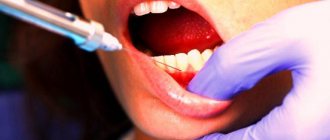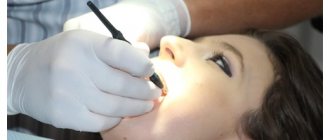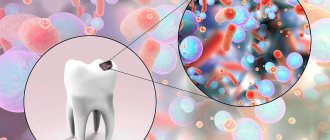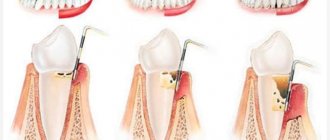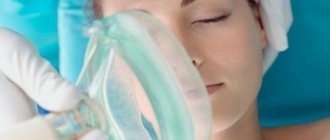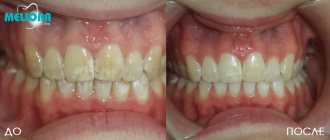What painkillers can you take while breastfeeding?
When breastfeeding, it is safe to take the following painkillers: Paracetamol, Ibuprofen, Drotaverine (“No-shpa”), Ketorolac (“Ketorol”, “Ketanov”, “Ketalgin”). Injections of lidocaine or articaine are suitable for pain relief during dental treatment. For local anesthesia for bruises and some other injuries, you can use ointments based on diclofenac.
| Allowed | Prohibited |
| Paracetamol | Metamizole sodium (Analgin) |
| Ibuprofen | Nimesulide (“Nimesil”, “Nise”) |
| Drotaverine ("No-shpa") | Acetylsalicylic acid (“Citramon”, “Aspirin”) |
| Ketorolac (“Ketorol”, “Ketanov”, “Ketalgin”) |
Is it possible to feed a baby immediately after dental treatment is completed?
Ideally, three to five hours should pass between the administration of the anesthetic and the application of the crumbs to the breast. Knowing this, a woman can prepare a portion of milk for one feeding.
During a forced break in lactation, it is recommended to pump. This simple measure will eliminate the occurrence of painful and unpleasant sensations.
Terms of use
Dr. Komarovsky, for example, recommends avoiding the use of painkillers while breastfeeding or pregnant, as some drugs simply have not undergone proper clinical studies. However, if a woman cannot tolerate severe pain, there is no point in waiting for it to go away on its own or using dubious traditional methods. Here are a few rules that will help you quickly deal with the problem and avoid harming yourself and your child:
- It is important to understand: painkillers only relieve the symptom, but do not cure the disease itself. Therefore, in case of painful discomfort, it is recommended to consult a doctor, find the cause of the discomfort and eliminate it. So, if you have a toothache, visit the dentist; if you have pain in your ear, visit an ENT doctor. If the root cause is not eliminated, the pain will occur again and again, requiring another dose of medication.
- Even for a drug prescribed by a doctor, check the instructions, or rather the section “Use during pregnancy and breastfeeding.” There are no prohibitions - take it, and in the recommended dosage. But! The quantitative transfer of drugs into mother's milk has been studied only for a few drugs. Therefore, in most cases, you will see that the drug has not been studied during pregnancy and lactation, or pregnancy and lactation are contraindications for use (precisely due to the lack of studies on this group). Some mothers try to reduce the harm of drugs by reducing the dose. It is not recommended to do this; the expected effect will not happen (especially if we are talking about products that are acceptable during breastfeeding!).
- Look in the instructions for an indicator that is important for us - the drug elimination period. As a rule, it is the same for blood plasma and breast milk. This way you can calculate the period when the drug leaves your body. Analgesics penetrate into the blood and into mother's milk at the same time: this requires only half an hour, the maximum concentration occurs after 1–1.5 hours. And they appear longer – up to 2–7. The half-life of paracetamol, for example, is about 3, and acetylsalicylic acid - up to 7.
Drug therapy during breastfeeding
- Levadnaya Anna Viktorovna
- Zhdanova Svetlana Igorevna
Summary
The importance of breastfeeding for the health of mother and child is currently beyond doubt. However, there are many reasons that can prevent full breastfeeding. In particular, drug therapy prescribed during lactation often leads to a temporary cessation of breastfeeding, often unjustified. This may lead to premature termination of breastfeeding. This article highlights the difficulties of prescribing drug therapy during lactation, the contradictions between existing international recommendations and the instructions for the drug, reflects current aspects of the pharmacokinetics of drugs in breast milk and provides practical recommendations on the way to solving the issues listed above.
Key words: lactation, breastfeeding, drug therapy, pharmacodynamics of drugs, pharmacokinetics of drugs, drugs in nursing, antibacterial therapy during lactation, physiology of lactation
For citation: Levadnaya A.V., Zhdanova S.I. Drug therapy during breastfeeding // Neonatology: news, opinions, training. 2022. T. 7. No. 4. P. 79-84. doi: 10.24411/2308-2402-2019-14006 The article was received by the editor on July 6, 2019. Accepted for publication on September 30, 2019.
The importance and necessity of breastfeeding today leaves no doubt. The benefits of breastfeeding for both the child and the mother have been proven by many scientific studies, so the issue of breastfeeding while taking various medications in hospitals is acute [1].
Many mothers are inappropriately advised to stop breastfeeding or avoid taking necessary medications due to fears of adverse effects on their children. This cautious approach is generally not justified because only a small proportion of drugs are truly contraindicated in breastfeeding mothers or are associated with adverse effects on their babies [2].
For example, in Russian practice, breastfeeding is often stopped in mothers with epilepsy who take valproic acid drugs (Convulex), although scientific studies demonstrate low penetration of valproic acid into breast milk and the absence of side effects in children whose mothers took these drugs during lactation [3] .
Domestic and foreign data on the admissibility of using a particular substance by a nursing woman contradict each other. This situation is explained by the fact that it is not economically profitable for the manufacturer to conduct studies of the drug during lactation and go through the full procedure for registering the substance as safe during lactation. According to the instructions, most drugs used in the postpartum period are not recommended during lactation [4].
All medications used by the mother should be reviewed on a case-by-case basis for potential contraindications.
When prescribing medications on the territory of the Russian Federation, the doctor must follow the official instructions of the manufacturer, which is regulated by Order of the Ministry of Health of Russia dated May 10, 2017 No. 203n “On approval of criteria for assessing the quality of medical care” [6]. On the website https://grLs.rosminzdrav.ru you can find instructions for drugs produced by different manufacturers [5]. Most drugs have not been studied by the manufacturer during breastfeeding, and the risks to the baby have not been assessed.
Information for clinicians regarding the extent of excretion of a particular drug into breast milk is necessary but may not be available [7]. To decide whether a particular drug is acceptable to use worldwide, the LactMed database https://toxnet.nLm.nih.gov [8] is used - a free and authoritative guide to the compatibility of drugs with lactation for prescription and over-the-counter drugs, which is published by the National Medical Library of the US National Institutes of Health. This resource contains all currently known data on drug levels in breast milk and infant serum, possible adverse effects on breastfed and lactating infants, and recommendations for alternative medications. The data is based on scientific research into breast milk and the penetration of various drugs into it. This database is updated every 1-2 months. There is also a free application for mobile devices on the LactMed website [9].
Pharmacokinetics and pharmacodynamics of drugs in breast milk
Drug diffusion into breast milk is driven primarily by concentration gradients that allow passive diffusion of non-ionized and free (non-protein-bound) drugs. Drug concentrations in breast milk are largely determined by drug concentrations in maternal serum [7]. Serum concentrations are generally lower when taking drugs with a large volume of distribution and fluctuate when taking drugs with a short half-life. There is also retrograde diffusion of drug from breast milk, whereby the drug can pass from the milk back into the plasma even if the mother has not emptied the breast [10]. Drugs that are high in protein, have a large molecular weight, or are poorly lipid soluble are rarely excreted in breast milk in clinically significant quantities. In the early postpartum period, large spaces between the alveolar cells of the mammary gland allow some substances to pass into breast milk that may not pass into mature milk. These gaps close by the 2nd week of lactation. Drug exposure during breastfeeding depends on the drug concentration in breast milk and the amount of breast milk consumed by the infant [7, 10]. The pharmacological activity of the drug depends on its absorption, distribution, metabolism and absorption by the child.
Criteria for assessing the risks of using medicines
The extent to which a child is exposed to substances taken by the mother depends on a number of factors.
1. Concentration of the drug in the maternal blood serum. Typically, drugs diffuse into and out of breast milk according to changes in maternal serum concentrations.
2. Penetration and concentration of the drug in milk. It does not depend on the volume of lactation. Drugs that have low lipid solubility or have a high molecular weight do not pass into breast milk. An example is the oral cephalosporin antibiotic ceftibuten. In the instructions.
3. Absorption of the drug in the child’s gastrointestinal tract. If the drug is not absorbed when taken orally, then even its significant concentration in breast milk will not lead to undesirable effects in the child. For example, the aminoglycoside antibiotic gentamicin, which has low bioavailability when administered orally.
4. Toxicity of the drug. Some pharmacological agents, even in small quantities, can have extremely adverse effects on many organs and systems of the child.
5. The risk of developing an allergic reaction in a child.
6. The ability of drugs to accumulate in the baby’s body even when small quantities are ingested.
7. Experience in using drugs in children. Medicines that are approved for use directly in children are usually safe because the doses transferred through breast milk are much lower than the therapeutic doses given to children.
8. Gestational age and age of the child. The risk of drug toxicity is higher in premature and sick infants and is rare in children older than 6 months.
9. Bioavailability of the drug. Young children are not usually affected by medications with low bioavailability, such as insulin or heparin.
The benefits of breastfeeding for both the infant and mother must be weighed against the risk of infant exposure to the drug.
As an example demonstrating the discrepancy in Russian instructions and international approaches when using drugs during lactation, we can illustrate the recommendations for a number of drugs common in hospital obstetric practice (see table).
Practical recommendations
Minimizing the potential risk to children when the mother takes medications may include the following recommendations.
1. Avoid drug therapy whenever possible.
2. Use topical therapy whenever possible.
3. Medicines that are safe for use directly on the baby are generally safe because the doses transferred through breast milk are much lower than therapeutic doses.
4. Medicines that are safe during pregnancy are not always safe for nursing mothers.
5. Use reliable links to obtain information about the use of medications while breastfeeding.
6. If different manufacturers have different instructions for the same drug, in hospitals it is advisable to choose when purchasing drugs from those manufacturers whose instructions allow breastfeeding while taking the drug they produce.
When choosing medications:
■ select drugs with the shortest half-life and highest protein binding capacity;
■ choose medications that have been well studied in children;
■ choose intravenous medications with poorer oral absorption;
■ Select drugs with the lowest lipid solubility.
Dosing of drugs:
■ the longer the interval between taking the medicine and breastfeeding, the lower its concentration in milk;
■ It is necessary to breastfeed the baby before the mother takes medications again. Infant exposure to medications can be minimized by taking medications after breastfeeding and before the infant sleeps for long periods of time.
When prescribing drugs that are not recommended for breastfeeding according to the LactMed database, a woman is recommended to temporarily stop breastfeeding and express to maintain lactation (from two mammary glands for about 15-20 minutes per breast, and in the case of expressing colostrum - 5-7 minutes ; at least every 3 hours (or at least 8 times a day), not focusing on the volume of expressed milk. If necessary, contact a breastfeeding specialist. With the constant use of drugs prohibited during breastfeeding, a collective decision is made to suppress lactation.
As of 2015, the US Food and Drug Administration (FDA) stopped using risk categories (ABCDX) to indicate the perceived safety of drugs during pregnancy. The ABCDX system was replaced by the FDA with the PLLR (Pregnancy and Lactation Labeling Rule) system, obliging the manufacturer to include 3 new categories of mandatory information in the drug instructions: clinical trial data on the effect of the drug on pregnancy and childbirth; lactation; on reproductive potential [27]. This entailed a change in some instructions for drugs registered in the Russian Federation: data from clinical studies began to appear in them, including during lactation. On the one hand, this introduced objectivity, on the other, contradictions appeared in them.
Let us consider this contradiction using the example of valproic acid preparations. The instructions say: “the excretion of valproic acid into breast milk is low, its concentration in milk is 1-10% of its concentration in the blood serum. There is limited data on the use of valproic acid during breastfeeding, and therefore the use of the drug during this period is not recommended. Based on the literature data and limited clinical experience, breastfeeding can be considered during monotherapy with valproic acid, but the side effect profile of the drug, especially the hematological disorders it causes, should be taken into account” [3]. From this instruction it follows that taking valproic acid drugs during lactation is not recommended, but is not prohibited, since existing clinical studies report drugs from this group as one of the safest during lactation [28], which gives reasons to doctors motivated to breastfeeding and mothers should be prescribed these drugs during lactation on a strictly individual basis under the control of the child’s coagulogram and platelets. There are similar contradictions in the instructions for other drugs, in particular in the instructions for ceftriaxone, carbamazepine, methyldopa, etc.
Conclusion
In the Russian Federation, the situation currently remains unresolved and the problem is acute. Strict legal settlement of controversial situations is necessary in order to reduce unfounded cases of refusal to breastfeed, as well as legal protection for doctors who allow breastfeeding while taking prohibited medications. In controversial situations, the decision to breastfeed is made collectively, together with a clinical pharmacologist, and individually, weighing all the risks and benefits of both medications and breastfeeding.
Conflict of interest
. The authors declare no conflict of interest.
Literature
1. Davanzo R. Controversies in breastfeeding // Front. Pediatr. 2018. Vol. 1, N 6. R. 278.
2. Illamola SM, Bucci-Rechtweg C., Costantine MM, Tsilou E. et al. Inclusion of pregnant and breastfeeding women in research - efforts and initiatives // Br. J. Clin. Pharmacol. 2022. Vol. 84, N 2. R. 215-222.
3. Aydin B., Nayir T., Sahin S., Yildiz A. Olanzapine and quetiapine use during breastfeeding: Excretion into breast milk and safe breastfeeding strategy // J. Clin. Psychopharmacol. 2015. Vol. 35, N 2. R. 206-208.
4. Arguello B., Salgado TM, Fernandez-Llimos F. Assessing the information in the summaries of product characteristics for the use of medicines in pregnancy and lactation // Br. J. Clin. Pharmacol. 2015. Vol. 79. R. 537-544.
5. Drug safety
URL: https://grls.rosminzdrav.ru/Default.aspx
6. Order of the Ministry of Health of Russia dated May 10, 2017 No. 203n “On approval of criteria for assessing the quality of medical care.”
7. Rowe H., Baker T., Hale TW Maternal medication, drug use, and breastfeeding // Pediatr. Clin. North Am. 2013. Vol. 60. R. 275.
8. National Library of Medicine LactMed Database. (date of access September 2019)
URL: https://toxnet.nlm.nih.gov
9. URL: https://toxnet.nlm.nih.gov/help/newtoxnet/lactmedapp.htm
10. Hale T. Medications and Mothers' Milk. 14th ed. Amarillo, TX: Hale Publishing, 2010.
11. Kaplan YC, Keskin-Arslan E., Acar S. et al. Teicoplanin use during breastfeeding // Breastfeed. Med. 2022. Vol. 12. R. 124.
12. Fraissinet F., Lesourd M., Naudoux N. et al. Pharmacokinetics of teicoplanin in a breastfeeding mother // Breastfeed. Med. 2022. Vol. 12. R. 244-246.
13. Festini F., Ciuti R., Repetto T. et al. Safety of breast-feeding during an IV tobramycin course for infants of CF women // Pediatr. Pulmonol. Suppl. 2004. Vol. 27. R. 288-289.
14. Boda A. Gentamicin concentration in the milk of a mother after treatment by implants of a Septopal chain // Orv. Hetil. 1990. Vol. 131. R. 2263-2265.
15. Celiloglu M., Celiker S., Guven H. et al. Gentamicin excretion and uptake from breast milk by nursing infants // Obstet. Gynecol. 1994. Vol. 84. R. 263-265.
16. Cherif F., El Aidli S., Kastalli S. et al. Drug induced urticaria via breastfeeding // Fundam. Clin. Pharmacol. 2009. Vol. 23, suppl. 1. R 37.
17. Berens P, Eglash A, Malloy M et al. ABM Clinical Protocol No. 26: Persistent pain with breastfeeding // Breastfeed. Med. 2016. Vol. 11. R 46-53.
18. Manninen AK, Juhakoski A. Nifedipine concentrations in maternal and umbilical serum, amniotic fluid, breast milk and urine of mothers and offspring // Int. J. Clin. Pharm. Res. 1991. Vol. 11. R 231-236.
19. Duke ME, Britten FL, Pretorius CJ et al. Maternal metyrapone use during breastfeeding: Safe for the breastfed infant // J. Endocr. Soc. 2022. Vol. 3. R 973-978.
20. Ryu RJ, Easterling TR, Caritis SN et al. Prednisone pharmacokinetics during pregnancy and lactation // J. Clin. Pharmacol. 2022. Vol. 58. R 1223-1232.
21. Smuin DM, Seidenberg PH, Sirlin EA et al. Rare adverse events associated with corticosteroid injections: a case series and literature review // Curr. Sports Med. Rep. 2016. Vol. 15. R 171-176.
22. Davanzo R., Bua J., Paloni G., Facchina G. Breastfeeding and migraine drugs // Eur. J. Clin. Pharmacol. 2014. Vol. 70, N 11. R 13131324.
23. Anderson PO, Manoguerra AS, Valdes V. A review of adverse reactions in infants from medications in breastmilk // Clin. Pediatr. (Phila.). 2016. Vol. 55. R 236-244.
24. Constantinescu S., Pai A., Coscia LA et al. Breast-feeding after transplantation // Best Practice. Res. Clin. Obstet. Gynaecol. 2014. Vol. 28. R 1163-1173.
25. Flint J., Panchal S., Hurrell A. et al. BSR and BHPR guideline on prescribing drugs in pregnancy and breastfeeding - part I: standard and biological disease modifying anti-rheumatic drugs and corticosteroids // Rheumatology (Oxford). 2016. Vol. 55. R 1693-1697.
26. Gotestam Skorpen C., Hoeltzenbein M., Tincani A. et al. The EULAR points to consider for use of antirheumatic drugs before pregnancy, and during pregnancy and lactation // Ann. Rheum. Dis. 2016. Vol. 75. R 795810.
27. Brucker MC, King TL The 2015 US Food and Drug Administration Pregnancy and Lactation Labeling Rule // J. Midwifery Womens Health. 2022. Vol. 62, N 3. R. 308-316.
28. Crettenand M., Rossetti AO, Buclin T., Winterfeld U. Use of antiepileptic drugs during breastfeeding: what do we tell the mother? // Nerve-narzt. 2022. Vol. 89, N 8. R. 913-921.
Dental treatment
Some young mothers are afraid to go for dental treatment because they read somewhere that anesthesia can have a bad effect on the quality of breast milk. In reality, this is not so: the doctor gives a local injection, which has a short-term effect and is quickly eliminated from the body, and therefore does not cause any harm to the baby’s health? As stated in the online magazine “Doctor Zubov”. So it is possible and necessary to treat teeth with pain relief during lactation. It is better to clarify in advance which drug will be administered to you, and inform the dentist about breastfeeding. In this case, the doctor will select the optimal remedy that will not only provide excellent pain relief during dental treatment, but will also be eliminated from the body as quickly as possible.
Symptoms of pathology
Mastitis is characterized by increased body temperature, in contrast to lactostasis, in which the temperature rises in the diseased gland itself and in the surrounding area.
The general state of health worsens, pain in the chest is felt not only when touched, but also when moving, moving the arm, general weakness is noted, and the disease is often accompanied by a headache. After feeding or pumping, the temperature does not decrease.
There are uninfected mastitis, infected mastitis and breast abscess.
Symptoms of uninfected mastitis:
- your health worsens, the inflamed areas hurt, pain can be felt when walking or changing position;
- the temperature can be from 38 degrees and above.
Treatment: With effective breast emptying, the condition improves within 24 hours.
If there is no improvement, then most likely we are talking about infected mastitis:
- part of the chest becomes red and hot, painful when touched;
- the temperature is elevated and lasts for more than 2 days with effective emptying of the breast.
Treatment: you can use compresses, except alcohol (alcohol blocks the hormone oxytocin, which is responsible for the outflow of milk);
antibacterial drugs compatible with breastfeeding are prescribed. Infected mastitis can progress to the abscess stage:
- a cavity with purulent contents forms at the site of compaction;
- high temperature.
Self-diagnosis: to find out whether there is pus in the milk, you need to express the milk onto a cotton swab - the milk will be absorbed, but the pus will not. Treatment: surgical, systemic antibacterial drugs.
List of approved drugs
Now a woman can turn to the Internet for help: just enter the appropriate name of the medicine into a search engine, and several sites will tell you whether it is allowed to be taken during pregnancy or lactation. For example, there is a universal reference book e-lactation. If we talk about painkillers, which are usually used for severe headaches and toothaches, as well as during extremely painful periods, here is a complete list of tablets that you can take, as well as intramuscular, external and rectal agents:
- Preparations containing paracetamol reduce temperature and pain, and also help to subside inflammatory processes. The main part leaves the body a couple of hours after administration.
- Ibuprofen-based drugs work for toothache, discomfort in joints and muscles. Suppositories and tablets relieve fever and help cope with the symptoms of ARVI. When using medications, less than one percent of the active substance gets into the milk - this is completely safe for the baby.
- Of the antispasmodics, that is, drugs that relax smooth muscles and relieve spasms, no-spa is allowed during breastfeeding. The drug eliminates discomfort in the intestines and can be used for stomach cramps or renal colic.
- If a nursing mother needs to treat caries or remove a tooth, injections of ultracaine or lidocaine can be used to anesthetize these processes. They quickly provide an analgesic effect and are then just as quickly eliminated from the body.
- In case of particularly severe pain syndrome, it is allowed to take “Ketorol” (also known under the names “Ketanov” and “Ketalgin”). This non-steroidal anti-inflammatory drug quickly provides pain relief. Used for migraines and menstrual pain. Two hours after administration it passes into breast milk, but its concentration is so low that even American and European doctors allow Ketorol to be taken by nursing mothers.
- Diclofenac. If the pain appears as a result of a bruise, sprain or other “sports” injury, doctors suggest using special anti-inflammatory pain-relieving ointments. The substance does not affect the quality and quantity of milk in any way and is quickly eliminated from the body. Diclofenac is contraindicated in people with high blood pressure or peptic ulcers.
What medications are chosen for lactation?
In modern pharmacology, there are many different pain relievers. However, when taking most of them, the mother is strictly forbidden to feed the child, since they have strong side effects on the baby’s body. A specialist can tell you what painkillers a particular mother can take while breastfeeding, depending on the characteristics of her body and the baby’s body.
Making a decision on your own is strictly prohibited, since medications can harm the baby. In the list below we give just examples of factors that a doctor takes into account when prescribing medication for a mother suffering from pain:
- toxicity level . The higher the level of toxicity, the more likely it is that you cannot feed the baby while taking the medicine;
- penetration into milk. In order to continue breastfeeding your baby while pain is being treated, it is important to choose a medication that does not pass into breast milk;
- removal rate . The drug, which is eliminated from the mother’s body no later than half an hour, can be taken to relieve pain after feeding, and it will not harm the nursing baby;
- time of action . Quickly relieving pain is very important for a nursing mother;
- contraindications . If a pain reliever is prohibited when feeding an infant, it is not prescribed;
- side effects;
- how does it affect breast milk?
- method of administration and dosage;
- a course of treatment.
Taking into account all of the above factors, the doctor prescribes painkillers for the mother during lactation, which have a minimum of contraindications and are as gentle as possible on the baby’s body. These may be drugs that have a weak analgesic effect or are quickly eliminated from the body.
Prohibited drugs
All of these pills are almost certainly in your medicine cabinet. But they are strictly prohibited for women who are breastfeeding. This list included:
- Analgin. In most countries, this drug is generally prohibited for use (not only by nursing women), as it contains a substance that provokes the development of agranulocytosis. If it gets into breast milk, it has an extremely negative effect on the functioning of the baby’s kidneys and circulatory system. Analgin is part of Baralgin, Tempalgin, Spazmalgon, Pentalgin, Spazgan. Approved for use only in the most extreme cases, at high temperatures that are not affected by other medications. Then an intramuscular injection of analgin with diphenhydramine and papaverine is given. However, only a doctor can prescribe such radical methods!
- "Nimesil" ("Nise", "Nimid" and other drugs based on nimesulide). Has an almost instant pain relieving effect. But due to the lack of a sufficient number of clinical studies, it is prohibited for use by pregnant and lactating women, as well as children under 12 years of age.
- Acetylsalicylic acid (aspirin and citramone). It negatively affects the functioning of the gastrointestinal tract of the baby and contributes to disruption of the kidneys and hematopoietic system.
Anesthetics that can be used by nursing mothers
In dentistry, pain relief is usually classified into general and local. In the first case, we are talking about anesthesia - intravenous or inhalation. Local anesthesia is the numbing of an inflamed area using an injection, gel or spray. It is highly undesirable to use general anesthesia when providing dental care to nursing mothers. If this cannot be avoided, then until complete recovery the woman should feed the baby with a special infant formula or pre-prepared breast milk.
Among the local anesthetics used by dentists are:
- Novocaine. Allowed during lactation only in cases where the expected benefit for the woman is much higher than the possible risks for the baby. Before administering the solution to the patient, the dentist must weigh the pros and cons. Sometimes the medication causes negative side effects: headaches, weakness, drowsiness, convulsions, dizziness, arrhythmia, bradycardia, swelling of the lips.
- Lidocaine. The official instructions state that only a doctor can prescribe medicine to breastfeeding women. The drug passes into milk in very small quantities, and its oral bioavailability is low. This means that the amount of active substance that is released in milk is minimal. Therefore, the potential harm to the child is low. Possible adverse reactions after the administration of lidocaine: numbness of the tongue, convulsions, drowsiness, tinnitus, blurred vision, angioedema, urticaria and some others.
- Articaine. A product approved for both pregnant and lactating women. Dentists use it if they need to perform infiltration or conduction anesthesia. Side effects of the drug include: nausea, vomiting, dizziness, low blood pressure, allergies.
Attention! Nursing mothers are prohibited from administering anesthetics that contain high amounts of adrenaline. Such drugs negatively affect the baby’s health, in particular, they provoke negative changes in the child’s cardiac activity.
How to reduce the likelihood of developing dental disease after childbirth
In order not to worry once again about dental diseases during the difficult period of recovery of the body after childbirth, it is important to follow the recommendations:
- At the pregnancy planning stage, cure all existing oral diseases.
- If caries appears, consult a doctor immediately. While the carious cavity is small, it can be treated absolutely painlessly without the use of anesthetics.
- Always practice good oral hygiene.
- Get routine checkups at your dentist's office twice a year.
Women who care about the health of their smile are much less likely to encounter the need for dental treatment during lactation.
Causes and symptoms of hemorrhoids
Hemorrhoids after childbirth are not uncommon
Very often, after childbirth, a woman develops hemorrhoids. This happens for several reasons:
- Stagnation of blood in the pelvic organs. This occurs due to high pressure on this area throughout pregnancy. But during childbirth, the pressure increases significantly, and this can lead to swelling of the veins and their protrusion into the rectum.
- Constipation
- Treatment of hemorrhoids throughout pregnancy
- Changes in hormonal levels. This occurs due to the fact that the level of progesterone in the blood increases
- Inactive and sedentary lifestyle
- Poor nutrition
- Difficult and protracted labor that lasted more than 10 hours
- Prolonged period of pushing
A woman’s body is most vulnerable at the moment when she is carrying a child, since all forces are directed precisely at this. Therefore, you should be more attentive to yourself and your health so that you don’t have to undergo treatment later. The main symptoms of hemorrhoids include:
- Bleeding, which can be either strong or mild (when there is simply a trace of blood (a droplet) on the toilet paper)
- Itching and burning, which cause a lot of inconvenience and cause great discomfort, as they are often very strong
- Discomfort
- Pain in the anus. Depending on what stage of the disease and how advanced it is, the pain syndrome will be different. Sometimes it can be a simple tingling sensation, and sometimes a severe pain attack, during which you have to take painkillers
- Prolapse of hemorrhoids. This happens with external hemorrhoids. In this case, the person feels great discomfort, since the nodes fall out quite strongly, and they also hurt
In most cases, hemorrhoids do not manifest themselves acutely. But, like any disease, there is an acute stage of manifestation that requires immediate medical intervention. Typically, during acute hemorrhoids, a person experiences severe pain, body temperature rises, and the color of the hemorrhoids changes, they become blue and swollen.
For a woman who is breastfeeding, the main thing to remember is that when the very first signs of hemorrhoids appear, you should immediately consult a doctor so that he can prescribe the correct treatment. Since during lactation it is allowed to be treated only with certain drugs.
Personal hygiene products
Such medications, although they are not taken orally, can enter the baby’s body through feeding. These are products for treating nipples and areas around them after feeding, to prevent cracks and inflammation. Most often, widely used drugs are prescribed - for example, Vinilin (Shostakovsky balm). It does its job quite well - preventing cracks, infection and moisturizing. But before each feeding, it must be washed off the breast (or washed with a damp sanitary napkin), since the chemical compounds included in its composition should not enter the baby’s body.
But the product for the prevention (and treatment) of superficial cracks in the nipples, Purelan, consists of medical lanolin, without additives or preservatives. This is a hypoallergenic cream, tasteless and odorless. It effectively moisturizes the nipples, and, what is especially convenient, it does not need to be washed off before feeding. In addition, the cream can be used to moisturize the baby's lips (this may be necessary if the breasts are very sensitive). There are other products recommended to prevent cracked nipples, but they need to be washed off before feeding.
Medicines for menstrual pain
In case of more pronounced and severe pain and the absence of any pathology, it is worth connecting medicinal treatment, such as painkillers during menstruation, these can be: analgesics (eliminate pain from mild to moderate);
antispasmodics; nonsteroidal anti-inflammatory drugs (NSAIDs), which relieve moderate to severe pain); oral contraceptives (hormonal birth control pills that normalize the reproductive function of the female body).
Nonsteroidal drugs
They contain Ibuprofen and are suitable even for teenage girls. Such drugs fight inflammatory processes and relieve spasms. Within 30-40 minutes after administration, you can feel significant relief.
Oral contraceptives
Birth control pills contain hormones that suppress ovulation. No ovulation - no painful menstruation. Among other things, they will relieve you of the symptoms of PMS (premenstrual syndrome). But keep in mind that you need to select such pills individually and only your gynecologist can do this based on the results of examinations and tests. The same hormones can be obtained in other ways, not only in tablets. For example, these could be: injections; hormonal patches that are glued to the skin; implants that are implanted under the skin of the arm; intrauterine device with hormonal effect.
Ointments
Particular caution should be exercised when using all ointments, especially those containing hormonal preparations of the adrenal cortex. There are a lot of such ointments: Hydrocortisone, Corticomycetin (it also contains chloramphenicol), Prednisolone, Dermosolone, Laticort, Fluorocort, Kenalog, Silanar, Locacorten, Loriden, Celestoderm, Deperzolon. Whether a nursing mother can use these ointments depends on how large the surface to be lubricated is, how often it needs to be lubricated and what the preparation is. Therefore, if there is a need to use such ointments, you should definitely consult a doctor.
